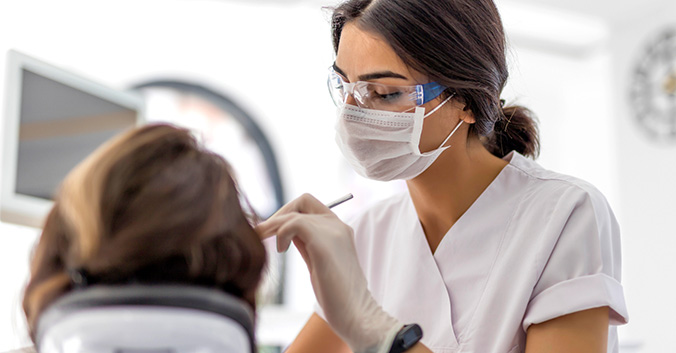
A guide to screening patients for oral cancer
If you take five minutes during an oral exam to check a patient for oral cancer, you could save a life.
In 2021, some 53,000 Americans were diagnosed with oral cancer, according to the Oral Cancer Foundation. This number has steadily risen over the last decade, and the COVID-19 pandemic has raised the risk even more.
A study in the Journal of the American Dental Association found that tobacco and alcohol use has risen during the pandemic. Weight gain, poor diet and oral hygiene and a lack of treatment over the past two years have also increased the risk.
If you aren’t already screening your patients, now’s a good time to start. As with most cancers, early detection is a key to survival. If oral cancer is diagnosed at an early stage, the five-year survival rate is 85%.
Who’s at risk for oral cancer?
Oral cancer can include cancers in the gums, tongue and back of the throat. It occurs most often in people over the age of 40. Risk factors for oral cancer include tobacco and alcohol use, prolonged exposure to the sun and infection with certain types of the human papillomavirus (HPV). More men than women are diagnosed with it.
What are the symptoms of oral cancer?
The best way to diagnose oral cancer is by performing a quick but thorough screening as part of a patient’s regular exam. Look for:
- A sore in the mouth that doesn’t heal
- A white or red patch in the mouth or on the lip or tongue
- A sore throat or a feeling that something is caught in the throat
- Difficulty chewing, swallowing, or speaking
- Difficulty moving the jaw or tongue
- Swelling in the jaw that causes dentures to fit poorly or become uncomfortable
- Numbness in the tongue or other areas of the mouth
- Voice changes
- A lump or mass in the neck
- Ear pain
The Centers for Disease Control and Prevention recommends checking the following areas of the mouth for signs of cancer:
- Lymph nodes. Check the nodes in the neck and under the lower jaw.
- Cheeks and lips. Look for red or white patches.
- Gums. Notice any lumps or spots.
- Tongue. Pull the tongue forward and look for any swelling or abnormal color or texture. Also check the base of the tongue and underside.
- Palate and back of throat. Look for any abnormalities.
- Floor of the mouth. Check for lumps or sensitivity.
Conducting these exams not only saves lives, but it can also help protect you against malpractice. Patients will appreciate the extra care you take. Take the five minutes. Your patients will thank you.
Recent posts
- Updated 2026 CDT codes are here
- Partner with us to improve the health outcomes of our shared members
- Say hello to our 2026 Medicare Advantage DHMO partners
- Say hello to our 2026 Delta Dental Medicare Advantage™ PPO partners
- Insights from Dr. Allen Edwards on oral cancer detection and prevention
- Create a PPO strategy for your dental practice
- Dr. Brian Hathcoat — how a career change and a commitment to service made a positive impact
- Menopause and the mouth: What our survey results are saying
- Ready, set, authenticate with multi-factor authentication
- Partners in care: Reduce patient grievances with our on-demand webinar
